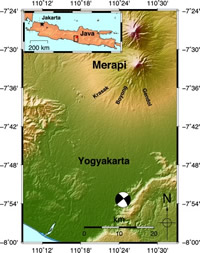Earthquake induced variations in extrusion rate: A numerical modeling approach to the 2006 eruption of Merapi Volcano (Indonesia) Short communication
Carr B.B., A.B. Clarke, M. de’ Michieli Vitturi (2018)
Earth and Planetary Science Letters, 482, 377-387, https://doi.org/10.1016/j.epsl.2017.11.019
Abstract
Extrusion rates during lava dome-building eruptions are variable and eruption sequences at these volcanoes generally have multiple phases. Merapi Volcano, Java, Indonesia, exemplifies this common style of activity. Merapi is one of Indonesia’s most active volcanoes and during the 20th and early 21st centuries effusive activity has been characterized by long periods of very slow (<0.1 m3 s−1) extrusion rate interrupted every few years by short episodes of elevated extrusion rates (1–4 m3 s−1) lasting weeks to months. One such event occurred in May–July 2006, and previous research has identified multiple phases with different extrusion rates and styles of activity. Using input values established in the literature, we apply a 1D, isothermal, steady-state numerical model of magma ascent in a volcanic conduit to explain the variations and gain insight into corresponding conduit processes. The peak phase of the 2006 eruption occurred in the two weeks following the May 27 Mw 6.4 earthquake 50 km to the south. Previous work has suggested that the peak extrusion rates observed in early June were triggered by the earthquake through either dynamic stress-induced overpressure or the addition of CO2 due to decarbonation and gas escape from new fractures in the bedrock. We use the numerical model to test the feasibility of these proposed hypotheses and show that, in order to explain the observed change in extrusion rate, an increase of approximately 5–7 MPa in magma storage zone overpressure is required. We also find that the addition of ∼1000 ppm CO2 to some portion of the magma in the storage zone following the earthquake reduces water solubility such that gas exsolution is sufficient to generate the required overpressure. Thus, the proposed mechanism of CO2 addition is a viable explanation for the peak phase of the Merapi 2006 eruption. A time-series of extrusion rate shows a sudden increase three days following the earthquake. We explain this three-day delay by the combined time required for the effects of the earthquake and corresponding CO2 increase to develop in the magma storage system (1–2 days), and the time we calculate for the affected magma to ascend from storage zone to surface (40 h). The increased extrusion rate was sustained for 2–7 days before dissipating and returning to pre-earthquake levels. During this phase, we estimate that 3.5 million m3 DRE of magma was erupted along with 11 ktons of CO2. The final phase of the 2006 eruption was characterized by highly variable extrusion rates. We demonstrate that those changes were likely controlled by failure of the edifice that had been confining the dome to Merapi’s crater and subsequent large dome collapses. The corresponding reductions in confining pressure caused increased extrusion rates that rapidly rebuilt the dome and led to further collapses, a feedback cycle that prolonged the eruption. In a more general sense, this study demonstrates that both internal changes, such as magma volatile content and overpressure, and external forces, such as edifice collapse and regional earthquakes, can affect variations in eruption intensity. Further, we also demonstrate how these external forces can initiate internal changes and how these parameters may interact with one another in a feedback scenario.
https://www.sciencedirect.com/science/article/pii/S0012821X17306556


